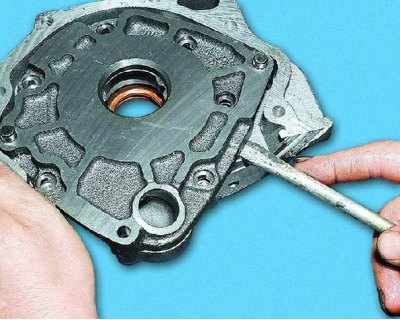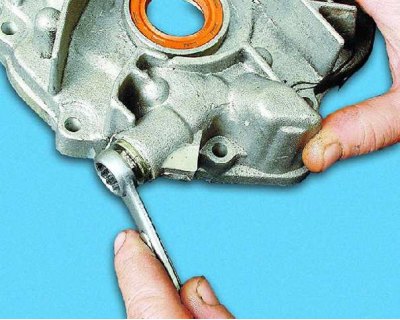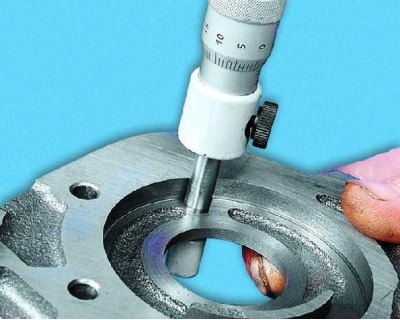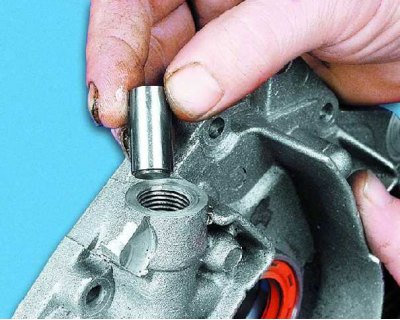- key "on 10"
- hexagons "by 5" And "for 8"
- two screwdrivers
- calipers
- micrometer
Remove the oil pump (see subsection 10.8.2.).

1. Remove the six screws securing the pump cover.

2. Using two screwdrivers, lift the pump casing until the dowel pins on the casing come out of the holes in the pump cover.

3. Remove the pump body from the cover.

4. Remove the drive from the cover and...

5.... pump driven gear.

6. Unscrew the pressure reducing valve (note: there is an aluminum sealing ring under the plug).

7. Remove the relief valve spring.

8. Remove the relief valve by gently tapping the body against a clean piece of wood. If the valve does not come out, remove it with a suitable tool, applying force only to its inner surface.

9. Examine the aluminum cover. In the contact area of the gears there should be no noticeable signs of wear, scuffing and deep scratches. Otherwise, replace the cover.

10. Inspect the pump housing. On its working surfaces there should be no noticeable signs of wear, scoring and deep scratches. Otherwise, replace the body.

11. Measure the diameter of the driven gear seat on the pump housing. Replace the housing if the diameter is greater than 75.1 mm.

12. Measure the width of the pump housing segment at the middle. If it is less than 3.4 mm, replace the housing.

13. Measure the thickness of the drive gear. If it is less than 7.42 mm, replace the gear.

14. Measure the thickness of the driven gear. If it is less than 7.35 mm, replace the gear.

15. To check the axial clearances of the gears, install the gears one by one into the housing, put a metal ruler on the housing and measure the gap between the ruler and the gear with a feeler gauge. The maximum allowable axial clearance is 0.12 mm for the drive gear, and 0.15 mm for the driven gear. If clearances are greater than specified, replace gears.

16. More precisely, the axial clearances of the gears can be calculated. To do this, measure the thickness of the housing along the outer surfaces with a micrometer and...

17.... the thickness of the housing in the area of the socket for the gears in several places (on milled surfaces). Calculate the axial clearance by subtracting the thickness of the gears from the arithmetic mean of the seat depth.

18. Inspect the relief valve seat. There should be no burrs or deep scratches on its inner surface. Otherwise, replace the cover.

19. Replace the relief valve if it has nicks or deep scratches.

20. Replace bent, broken, or cracked relief valve spring. The height of the spring in the free state should be 44.72 mm, and under load (4±0,24) kgf - 31.7 mm. Otherwise, replace the spring.

21. Replace the heavily compressed pressure reducing valve plug o-ring.

22. Install the driven gear into the pump housing. In this case, the chamfers on the gear teeth and along its outer radius must face the housing.

23. Install the drive gear into the pump housing. In this case, the chamfers on the gear teeth should be facing the housing.

24. Install the cover on the body and tighten the bolts of its fastening. Lubricate the pressure reducing valve with engine oil and install it upside down in its seat. Then install the spring and wrap the plug with the o-ring.

25. Pour 10–20 g of engine oil into the pump through the oil receiver hole.

26. Rotate the pump gears a few turns to lubricate their running surfaces. Gears should turn easily, without jamming.
